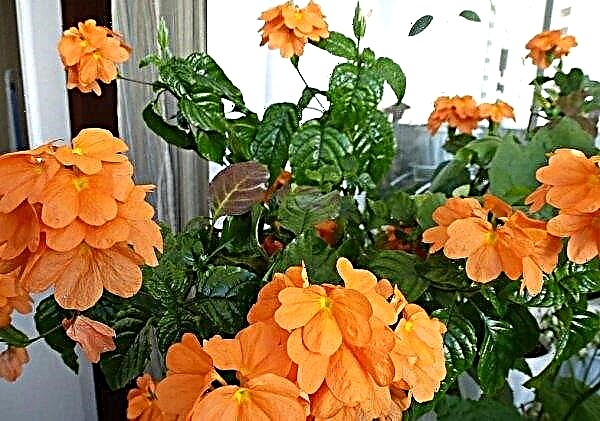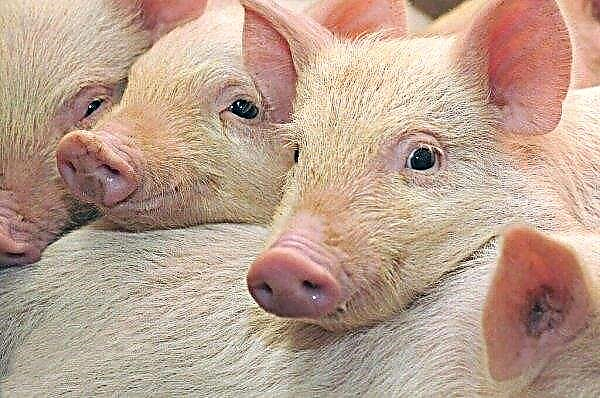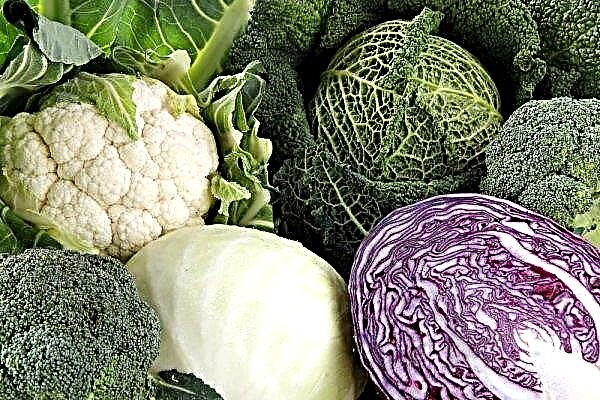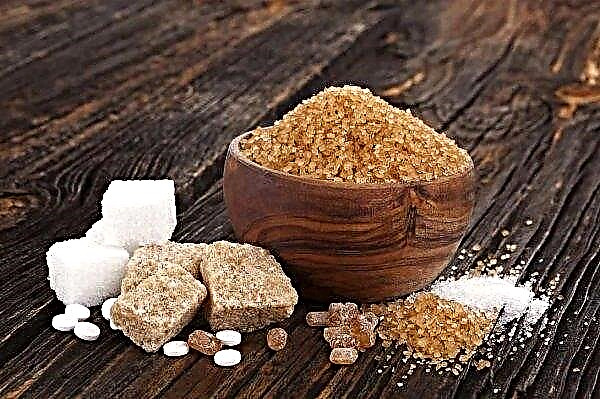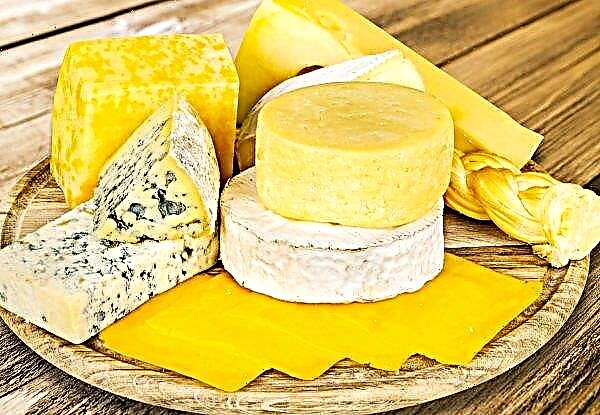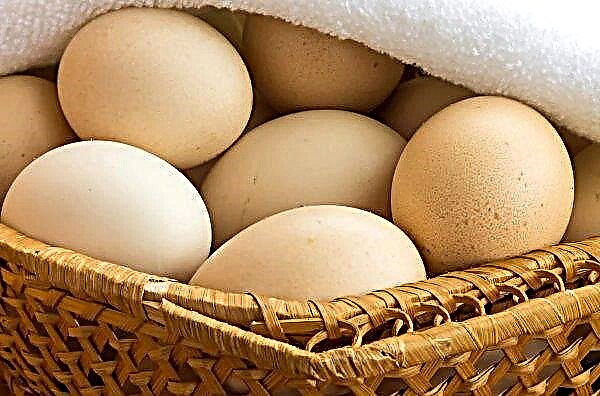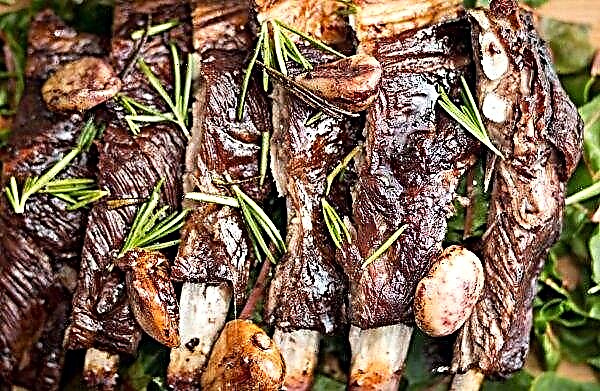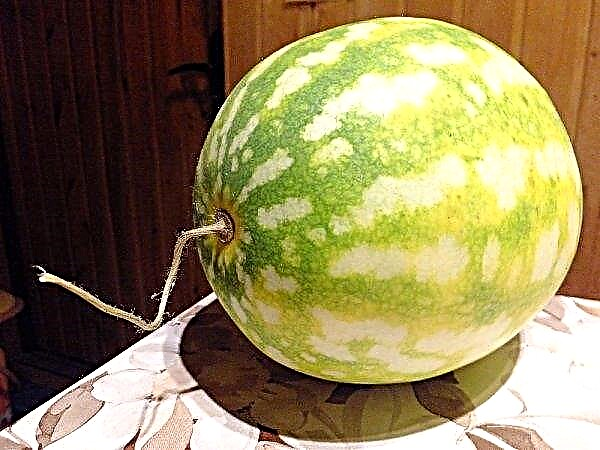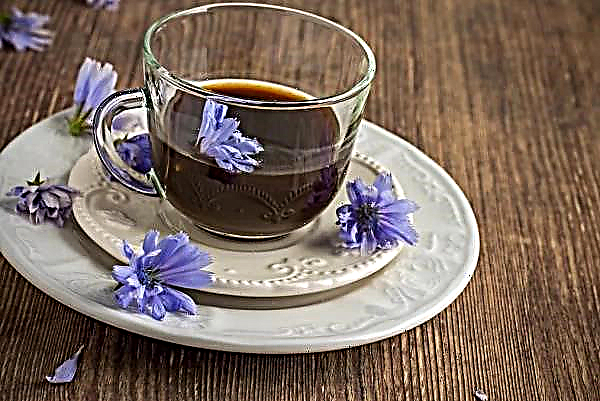Onions are among the most commonly used vegetables in our cuisine, and this is not surprising. Indeed, in addition to the spicy taste and aroma, it carries a large number of nutrients and vitamins. That is why almost on every summer cottage or garden onion is one of the obligatory crops for growing. Having a large number of varieties, it is difficult not to get confused in choosing the right one. Onion Stardust belongs to hybrids, the high characteristics of which will easily satisfy even the most demanding vegetable grower.
Description and characteristics of onions
Stardust F1 is one of the varieties of white onion, which has truly excellent characteristics. Bulbs have a round regular shape and medium size. Stardust has well-developed long feathers of bright green color. Many gardeners appreciate this variety not only for its taste (the vegetable has a spicy and semi-sharp taste), but also for its long shelf life.
Did you know? The first evidence of onion use in Europe dates back to the Bronze Age.
Ripening time
Stardust belongs to the early varieties of onions, the crop of which can be harvested 60 days after planting. Planting time depends on the need for gardeners - it can be a spring planting (in the first half of May) or autumn. Vegetable growers note that onions planted before winter have a more stable immunity to various diseases and pests.
 With proper care and regular treatment of weeds, such a variety can produce an even more abundant crop.
With proper care and regular treatment of weeds, such a variety can produce an even more abundant crop.
Disease resistance
Variety of onions Stardust has immunity to many common diseases (for example, powdery mildew, gray rot, as well as various viral diseases) and the invasion of pests (onion fly, insects living in the soil). Despite this, it is strongly recommended to systematically carry out preventive measures that can protect the crop from death.
Advantages and disadvantages
- The high characteristics of Stardust indicate the numerous advantages of onions over other varieties:
- great fecundity and quality feathers;
- high taste;
- persistent immunity to various diseases and pests;
- keeping quality.
Being a hybrid, this variety has the only drawback - the need for annual procurement of planting material.
Growing conditions
To get a rich harvest, starting to plant, you should take into account several basic rules for growing onions of this variety:
- for the full growth and development of the onion requires a sufficient amount of natural light;
- a properly selected frequency of irrigation plays a decisive role in the quality and quantity of the future crop - a lack of moisture will make the taste of the vegetable too bitter, and excessive watering will lead to the development of rotting processes;
- having low resistance to cold, onions will disappear if the soil temperature is below +10 ... + 15 ° С.
 During watering or eliminating weeds, it is necessary to thin out the onion planting at the same time, removing the weakest sprouts
During watering or eliminating weeds, it is necessary to thin out the onion planting at the same time, removing the weakest sprouts
Seed growing for seedlings
Stardust is one of many hybrid varieties. Such onions can be grown in just one season, which compares favorably with other varieties when you need to get onion sets in one summer and turnip only the next year.
How to prepare seeds
Despite the fact that the result of sowing onion seeds most often gives positive results, obtaining the guaranteed and high-quality seedlings can only be ensured by proper seed preparation, which consists of several stages:
- Rejection - the seeds are filled with warm water for several hours and those that have surfaced are considered empty or too small for sowing, so they are removed.

- Disinfection procedure - onion seeds can be carriers of various viral or fungal diseases. In order to destroy possible diseases, the seeds are placed in a gauze bag and lowered for 20 minutes in a weak solution of potassium permanganate, after which they are thoroughly washed under running water. After this, it is recommended to soak the seeds for 15–20 hours in a biostimulant solution. As a substitute for potassium permanganate, a 1% solution of 10 g of potassium permanganate is often used, which is diluted in 1 liter of water.

- Warming up - such a procedure provides simultaneous shoots. For this, the seeds are immersed in water with a temperature of about 40 ° C for half an hour.

- Quenching - allows future seedlings to activate resistance to adverse climatic conditions. After warming up, planting material is placed in the refrigerator for half an hour.

- Germination - the procedure helps to speed up the first shoots. To this end, the seeds are laid out on a paper or cloth napkin (preferably made of natural fabric) moistened with water and covered with a dense layer of gauze, which should be systematically moistened. During the first week, the seeds begin to germinate, after which they should be sown in moist soil and constantly watered until the first seedlings are obtained.
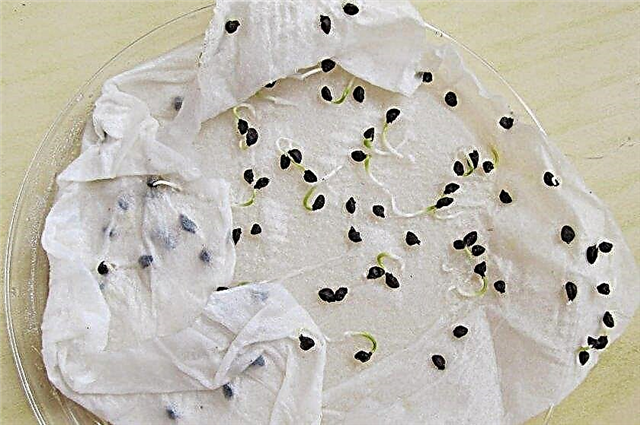
What is the best way to grow
When conducting work on preparing seeds for sowing, first of all, you should decide on the capacity for future seedlings. When making a choice, several points should be taken into account:
- the size of the container should correspond to the size of the windowsill or other place where the seedlings will grow;
- the tank must have reliable drainage holes and a tray where excess water will drain;
- the material of the container should be rigid, but light enough - wood or plastic is best;
- Before using the container, it must be washed and disinfected, therefore, plastic is a more suitable option;
- the packaging material should also not have high thermal conductivity, which will negatively affect the roots of plants.
Seed planting process
The procedure for sowing black onion is usually carried out in late February. In this case, the grown seedlings will be ready for planting in open ground in late April. For future seedlings, use a ready-made soil mixture for growing vegetables or soil from a greenhouse.
Before sowing seeds, the soil in the tank is well loosened and leveled. Next is the preparation of the rows - the depth is about 2 cm, and the gap between the rows is about 30–40 cm. The soil is necessarily well moistened with water. Chernushka is sown approximately 1-1.5 cm from each other - this distance will provide a minimum number of plant injuries during thinning. Then the soil is carefully compacted.
 Productivity of Stardust onions when grown on herbs is up to 3 kg / m2
Productivity of Stardust onions when grown on herbs is up to 3 kg / m2
Before the first shoots appear, the container with the seeds planted is covered with glass or film, which creates a greenhouse effect, without forgetting to remove it daily for a short time.
At the first shoots, the first thinning is carried out, since during this period the rhizome is not yet sufficiently developed. The distance between the shoots at this stage should not be less than 2 cm. The optimum temperature regime for seed germination is +22 ... + 24 ° C, and when seedlings appear, +18 ... + 20 ° C.
Important! Particular attention should be paid to watering. — lack of moisture can lead to lack of seedlings, and excessive watering — to the development of fungal diseases.
Further care
With the advent of the first shoots, the film or glass is removed from the surface of the container, and further care is not particularly difficult. There are just a few basic rules that you should pay attention to:
- Watering - carried out systematically as soon as the topsoil dries. Drying of the soil and its excessive moistening must not be allowed.
- Top dressing - carried out in two stages with an interval of 10-14 days. As fertilizers, a mixture of superphosphate (20 g), potassium chloride (5 g) and urea (10 g) diluted in 10 liters of water are used. It is also possible to feed the seedlings with chicken droppings diluted in water (ratio 1:10).
- Lighting - Young shoots are in dire need of lighting lasting 12 hours. Relying only on the light day of the beginning of spring, it is practically impossible to obtain the required number of hours. Therefore, artificial lighting is often used in the form of a phytolamp, LED or fluorescent lamp, which is placed at a distance of 20-25 cm from the seedlings. The first few days, such devices work constantly, and then - about 10-12 hours during the day.
- Pinch - carried out at the stage of development of the third pen. During this period, the leaves of seedlings are shortened by 2/3 of their height, which prevents the fragility of seedlings.
- Quenching - A procedure that allows plants to develop resistance to adverse climatic and weather conditions. To do this, 7-10 days before the intended planting in open ground seedlings are exposed to the open air. Starting from 5-10 minutes, the time spent on the street is gradually increasing.

Features of open transplantation
Planting onion seedlings in open ground is carried out approximately 60 days after sowing, usually this time falls in the middle - the end of April. The following scheme is used for planting seedlings: rows are prepared in advance, with a depth of about 5 cm and an aisle of 25-30 cm. The distance between the planted seedlings is 10-12 cm.
Open field cultivation
Although the onion belongs to unpretentious plants, it is still very responsive to care - minimal care immediately affects the quantity and quality of the crop. There are a number of basic rules of agricultural activities, adhering to which in the future it is guaranteed to get a large number of crops.
Important! When growing onions, it is recommended to adhere to crop rotation rules. The most suitable precursors are cucumbers, pumpkin, zucchini, cabbage, tomatoes and legumes.
Site selection and soil preparation
The place chosen for planting onions should be flat and open to constant access to sunlight, without shading from bushes and trees. Depending on the composition of the soil, the properties of the onion will slightly change. So, in loamy soil, the taste of onions will be somewhat more energetic, and in loamy soil the vegetable will ripen faster. Unsuitable for this culture is heavy and clay soil, in which onions will give very rare seedlings.
Land for planting onions is prepared in the fall. After cleaning the garden, fertilizers are added to the soil at the site: organic and mineral, as well as wood ash (1/2 kg per 1 m²). To do this, use double superphosphate (based on 20 g per 1 m²) and potassium chloride (15 g per 1 m²), as well as humus (5 kg per 1 m²) and compost (8 kg per 1 m²). In addition, additional fertilizer of the soil with chicken droppings with a calculation of 0.2 kg per 1 m² is recommended.

Under the condition of growing onions in peat soil, part of the phosphorus fertilizers is increased by 1.5–2 times, while nitrogen fertilizers are completely abandoned. The next stage of the preparatory work is digging the site - the first time the soil is dug up and loosened to a depth of about 10 cm, and then later in the fall, again, but to a depth of 20 cm. With the beginning of spring, the earth is again loosened, which helps to keep more moisture in it, and later digged to a depth of 15 cm and re-apply mineral fertilizers - ammonium nitrate (20 g per 1 m²), as well as part of superphosphate and chloris that calcium.
Did you know? The amount of natural sugar in onions exceeds its content in apples and pears.
The process of planting seed in the ground
Immediately before planting, seedlings are inspected and sorted - well-developed and intact seedlings are suitable for planting. The feathers of plants are shortened by 1/3 of the length, which minimizes the evaporation of plant moisture. The roots are also slightly trimmed, after which the seedlings are placed in a solution of mullein and clay.

Using the previously outlined scheme, seedlings are planted in prepared and well-moistened holes to a depth of 3-4 cm, after which the beds are covered with earth and gently compacted. After a day, the planted seedlings are watered with humate, which allows plants to take root faster, and then mulch it with peat.
Experienced gardeners recommend growing onions in slightly raised beds - they are better warmed up, and also have an optimal air-water regime. Especially relevant this method will be in heavy soils. To do this, the height of the ridges is increased by 13-15 cm, and their width is up to 1 m. Planting seedlings in open ground is carried out in dry, not sunny weather, or in the afternoon (from 16-17 hours). Initially, seedlings are vulnerable to direct sunlight and possible frosts, so it is recommended to protect them with covering material thrown on rooted metal arcs.

Watering and fertilizing
Having an undeveloped root system, onions urgently need timely watering. From May to July, watering plants is carried out once a week. In hot and dry weather, the frequency of moisture is doubled. About 5-7 liters of water are required per 1 m². Starting in July, watering is stopped, but if the air temperature is constantly high, it is permissible to continue watering in small portions once every 7-10 days.
Fertilizing is an important procedure in obtaining a consistently high yield of onions. The best option is the introduction of complex mineral fertilizers into the soil once a month along with irrigation until early July.

Soil cultivation and weeding
Onions belong to crops whose yield decreases sharply when the soil is clogged with weeds, so it is advisable to weed every 2–3 days, removing weeds with an undeveloped root system. Also, after each irrigation it is recommended to carry out cultivation, avoiding the formation of a crust on the earth's surface. This will significantly enrich the soil with the necessary amount of oxygen.
Plant pests and diseases
Despite the fact that onions of the Stardust variety have a stable immunity to various diseases, nevertheless knowledge of diseases and the basic methods of control and prevention may be required for each gardener:
- Peronosporosis (or downy mildew) manifests itself in the form of wilting, as well as the formation of plaque and light spots on the feathers of the bow. The main period of activity of this fungal disease occurs in the spring. Appearing primarily on the green part of the plant, the disease gradually affects the bulb itself. Infected vegetables become the carrier of the pores of the fungus, which are able to maintain their vital activity until the next season. Treatment will vary slightly depending on the expected result: in the process of growing onions on turnips, it is permissible to treat it with fungicidal preparations. If the vegetable is grown on greens, chemical processing is considered unacceptable, and therefore, irrigation and the application of organic fertilizers are suspended for a short time, and potassium-phosphorus fertilizing should be introduced into the soil instead. As a preventive measure, the crop must be warmed up - before being sent for storage and 10-14 days before planting for 12 hours at a temperature of + 40 ° С. You should also annually treat the premises where the crop is stored with bleach, at a rate of 400 g per 10 liters of water. Such a procedure must be carried out at least 50-60 days before the intended laying of onions.
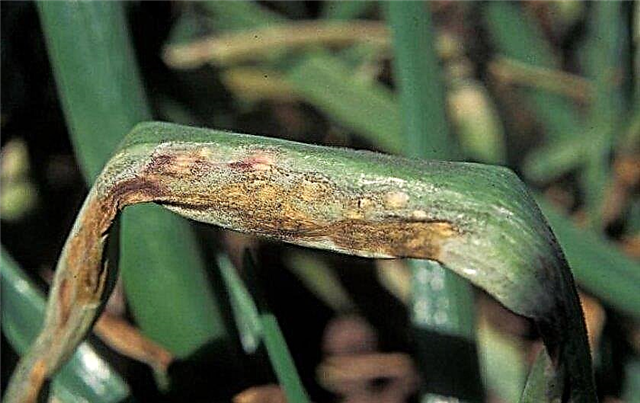
- Gray rot - a fungal disease that penetrates the onion during the drying procedure through the not closed neck of the vegetable. The main signs of the development of the disease are putrefactive neoplasms at the base of the neck, damage to the upper layers of the onion.The most suitable conditions for the formation of gray rot are high humidity and elevated storage temperatures. As a treatment, the beds are treated with systemic fungicidal preparations, as well as the restriction in nitrogen fertilizers and potassium-phosphorus fertilizers are applied - this method contributes to the rapid drying of greens and the artificial acceleration of bulb ripening.

- Bacteriosis - a fungal disease that also occurs when the storage regimen is violated. The main signs of the disease are onion softening and the appearance of an unpleasant odor, the formation of rotten layers, which are clearly visible when cutting the vegetable. As treatment and prevention, the same methods of control are used as with gray rot.
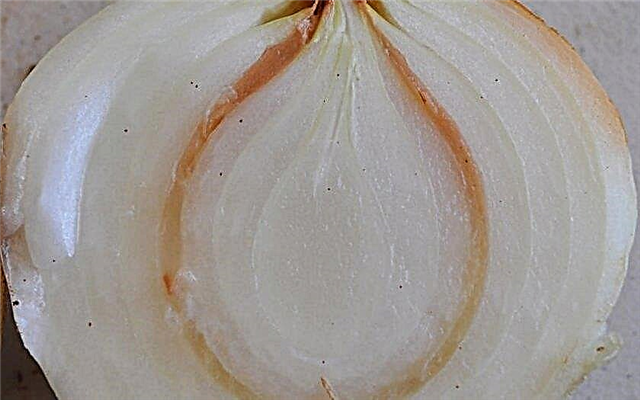
- Onion fly - a pest that lays larvae in the feathers of onions. Those, in turn, eating a plant, lead to its complete destruction - the bulbs begin to rot, and the aboveground part turns yellow and dries. The activity of onion flies is already evident in mid-May. As an insect control, chemical treatment or folk methods are used: sprinkling the beds with ash, processing with a solution of sodium chloride (with the calculation of 300 g of salt per 10 liters of water) or using alternating planting of onions - carrots, whose smell repels pests.
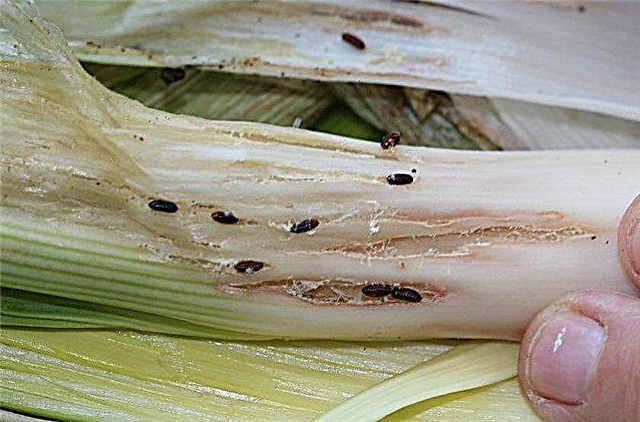
- Onion thrips - transfers winter cold in the remains of vegetation (uncleaned tops, leaves, etc.), and in the spring it moves to young plants, where it holds eggs. Pest affected onion feathers quickly lose color and die. To combat these insects, odor repellent is used - the beds are sprinkled with tobacco, ash or mothballs. Alternation of onion and carrot beds is also used.

There are several basic methods of prevention, adhering to which you can easily avoid most diseases and pests:
- since planting material is often the carrier of various diseases and pests, it is recommended that the plant be disinfected before planting in open ground using high temperatures;
- most pests and diseases tolerate winter cold in the soil and the remnants of uncleaned plants, therefore, during the autumn preparation of the beds, it is recommended to dig and disinfect the soil;
- correct crop rotation will help get rid of diseases.
Harvesting and storage
Harvesting onions can begin if the vegetables are ripe enough - the neck of the turnip has dried up enough, and the feathers have died. If the onion is already large enough, and frosts are expected ahead, its ripening process is accelerated artificially: they dig each turnip with villas.

After harvesting, each bulb is inspected. All rotten and spoiled vegetables are sent to the culling, and fruits with an incompletely dried neck are used in food. To extend the shelf life of the onion, its roots are burned with matches (but it should be noted that such an onion cannot be planted in the future).
Well-dried onions in the sun can be easily stored not only in cellars and refrigerators (at air temperatures of +1 ... + 5 ° C), but also in any house or residential building under the condition of a low level of humidity. The optimal storage containers are cardboard boxes (with small openings for ventilation) or fabric bags. The use of plastic bags in which the onion suffocates and begins to rot quickly is unacceptable.Important! When harvesting, it is recommended not to cut the onion feathers too close to the turnip, and treat the place of cut with lime paste — this preserves the crop and prevents it from germinating.
Despite the apparent simplicity of the growing process, onions can deliver some troubles to inexperienced gardeners. However, adhering to the basic rules of caring for this crop, and also not forgetting to prevent diseases and pest attacks, almost every summer resident can get a rich and high-quality crop.
Network user reviews
ADVANTAGES: Salad variety, healthy
DISADVANTAGES: Not stored for long, pungent taste
I usually plant several different varieties of onions, sign the beds to determine for myself what kind of variety I will like to plant in the future ... Now I want to talk about white onion - the variety is called Stardust ... I planted onions less often, on the head .. The young onion went well, along with the other varieties ... By the way, this year we had amazingly tasty and rich green onions ... I don’t know what this is connected with - or with the cool weather in May-June, which like onions ... But onions differed in height, beauty and taste from onions previous years ... White onion is considered to be lettuce, sweet, we expected this result ... Stardust belongs to the varieties not very sweet, with an average level of severity ... But when we bought seeds, we did not know about it, we thought, once white, then it should be sweet ... Dug up the onion, tasted it and became disappointed ... In principle, the sharpness of the onion is not very different from the usual yellow onion ... Well, maybe a little softer ... I thought, why to overpay, if there is practically no difference ... And Starvast sevok is more expensive than ordinary onions ... The crop was average, bulbs The onion scales are the thinnest, it’s even difficult to peel the onions ... And what upsets me most of all is that the white onions are not stored for a long time ... The heads begin to rot already in October ... And this means that it makes no sense to plant a lot of white onions, anyway we won’t be able to save it until spring, like a regular onion ... Therefore, if I plant white onions next year, I’ll now study which variety is really sweet and plant a little bit to eat in the summer ... And I recommend Starstast to those who likes white onions with medium severity ...











